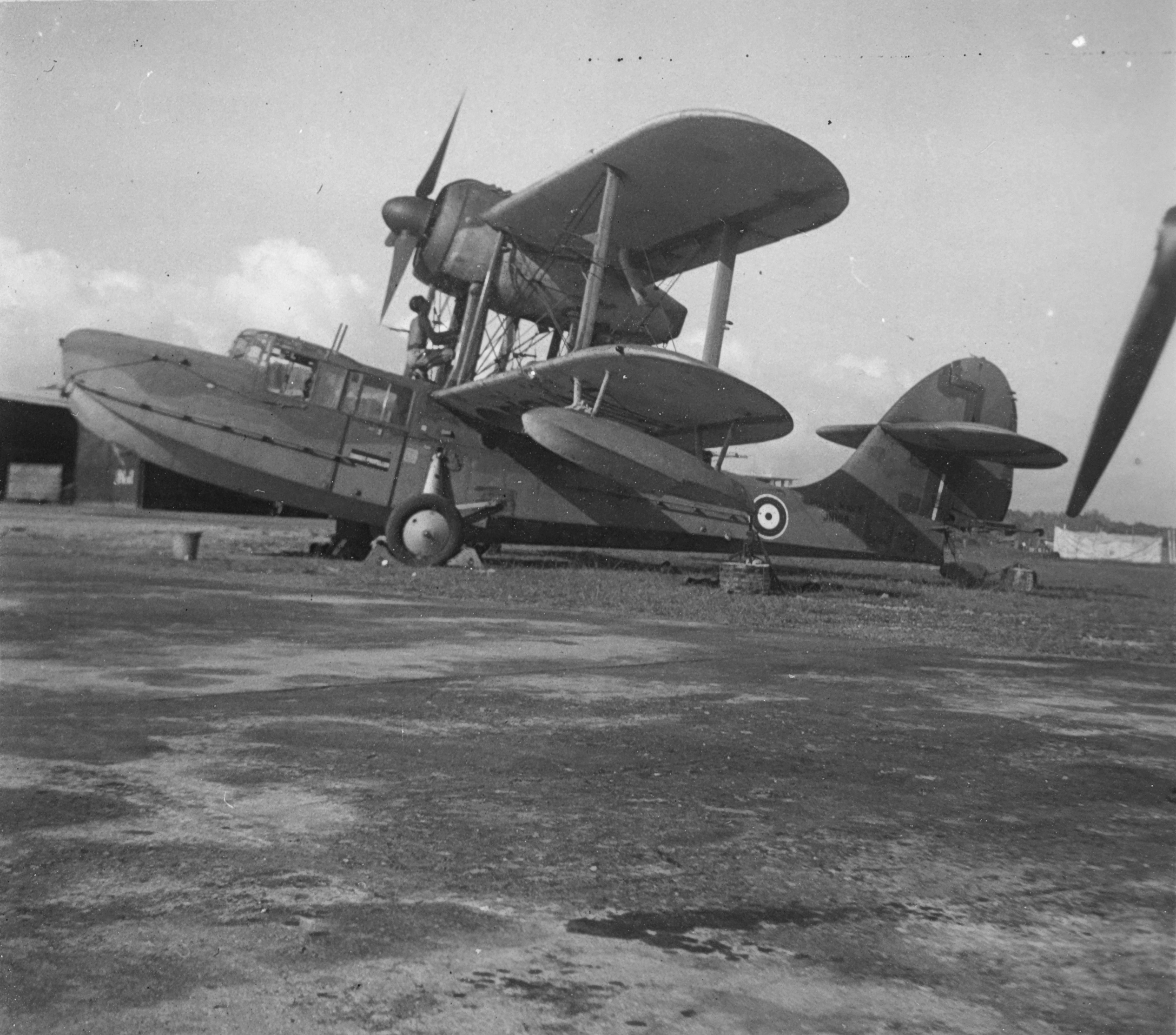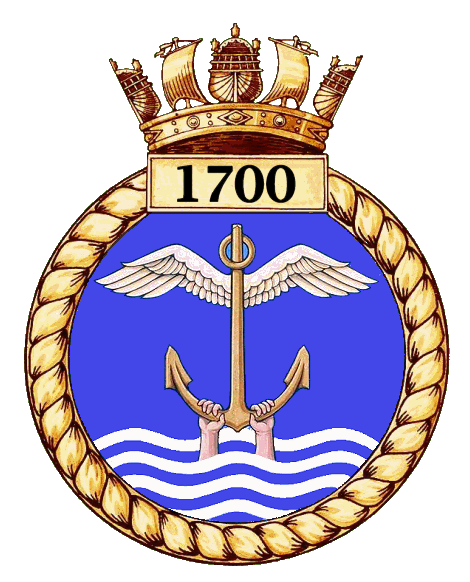



No.1700 Squadron formed at RNAS Lee-on-Solent on November 1st 1944 as an Air Sea Rescue (ASR) squadron with 6 Pilots and 6 Observers, Lt. (A) A. B. Edgar, RNVR in command. The squadron was issued with six Sea Otter Mk.I amphibians with which they conducted a short workup; records indicate only one flying incident, a tyre burst on Sea Otter JM907 while Sub-Lt G. Kiddie, RNVR was taxying causing the wheel to sink into soft ground off the runway on November 29th.
On completion of the work-up the squadron embarked in HMS KHEDIVE on January 8th 1945, at RNAMY Belfast [1]where the ship arrived on the 7th to embark a ferry load of reserve aircraft in addition to the 24 Hellcats belonging to 808 squadron which were already on board having flown out to the ship on the 5th. . KHEDIVE sailed on January 11th, in company with SPEAKER and SLINGER, for passage to Cochin, Southern India.
KHEDIVE arrived at Cochin on February 3rd and after unloading their aircraft 1700 squadron flew to RNAS Sulur, 120 miles to the Northeast, on the 8th. Here a number of Sea Otters, and several Walruses, were issued from nearby RN Aircraft Repair Yard at Coimbatore.

A Supermarine Sea Otter at RNAS Lee-on-Solent.
The squadron next moved to the RAF flying boat base at Koggala, Ceylon on April 4th 1945 to begin operations. Two of the newly acquired Walrus were detached to operate from escort carriers: one embarked in STALKER on April 14th the other embarked in HUNTER on April 23rd. These two carriers were part of the covering force for the sea borne assault on Rangoon on May 2nd codenamed Operation DRACULA.
HUNTER was also involved in conducting an anti-shipping sweep in the Andaman Sea in Operation MITRE and in Operation DUKEDOM, the search for the Japanese cruiser HAGURO later in May. The HUNTER detachment ended on June 12th and STALKER on the 24th. The ASR Walrus on HUNTER rescued two Avenger crews from 851 squadron during the DUKEDOM/MITRE operations; JZ103 and JZ138 both ran out of fuel and ditched returning from separate extended missions and failed to locate the fleet.
Meanwhile the squadron re-equipped with 6 Walrus and 2 Sea Otters on May 6th in preparation for a further move to RNAS Trincomalee on the 26th; this wad to be the squadron’s main base of operations. A single Walrus was embarked in KHEDIVE on June 12th to provide ASR cover during Operation BALSAM, a Photographic Reconnaissance of Southern Malaya and strikes against Sumatran airfields, then Operation CARSON, a series of anti-shipping and airfield disruption strikes off Penang in late June and finally Operation ZIPPER the reoccupation of Malaya in September. The detachment ended on September 18th when the ship returned to Trincomalee.
During July 1945 one Walrus (WB038) embarked in EMPEROR on the 2nd for a two week detachment during operations against Car Nicobar and minesweeping operations; on the 14th the aircraft struck the rounddown landing on EMPEROR, the pilot Sub-Lt A.B. Edgar and crew were unhurt. Another joined AMEER on the 19th for two days. On August 8th a single Walrus was embarked in SHAH when the ship began working up her squadron in readiness for the upcoming Operation JURIST, part of the overarching Operation ZIPPER, this was an amphibious assault to reoccupy Penang set for August 21st. Single Walrus detachments were also embarked in ATTACKER and HUNTER on August 16th for operation JURIST; the Japanese surrender was announced on the 15th and the force sailed from Trincomalee on the following day as planned to reoccupy Penang. Delays in negotiations resulted in the operation being delayed and then postponed; SHAH had returned to Trincomalee by the 28th, disembarking her Walrus on arrival. ATTACKER and HUNTER had been ordered to proceed to Rangoon and were allocated to participate in a revised Operation JURIST, the force reached Penang on the 28th, the surrender ceremony taking place on September 2nd. The force next sailed for Singapore to be present for the surrender ceremony there on September 12th 1945. HUNTER arrived back in Trincomalee on September 18th and disembarked her Walrus, ATTACKER followed suit on the 21st. There was to be one final detachment in October, a single Walrus embarked in EMPEROR on the 17th, disembarking on the 30th.

A 1700 Sqn Walrus taking off from the fight deck of the CVE HUNTER for an air sea rescue mission. Note the white bands painted on the main and tail planes, these markings were worn by all Eat Indies Fleet aircraft in 1945.
From November 1945 additional aircraft were issued at RNAS Trincomalee; at least 2 Avenger, 1 Seafire, 2 Tiger Moth, 4 Reliant, and 6 Swordfish were received and the squadron was reorganised into three Flights - ‘A’ Flight at RNAS Trincomalee, ‘B’ flight at RNAS Katukurunda and ‘C’ at RNAS Sembawang. 'C' Flight, equipped with Sea Otters, was the first to leave, briefly operating from the newly re-opened RNAS Sembawang in Singapore arriving there on November 8th before moving to RNAS Katukurunda on the 20th. The squadron was transferred to 2nd Line duties on November 24th when ‘B’ flight moved to RNAS Katukurunda. 'C' Flight returned to Sembawang on December 15th but the flight was absorbed into 791 squadron, the station’s resident Fleet Requirements Unit on January 26th 1946.
The squadron had a very good flying record while operational in Ceylon with only one major and a small number of minor incidents recorded; while making a water landing at RAF Koggala on April 19th Lt Edgar in Sea Otter JM755 dropped his starboard wing causing the aircraft to drift into the stand. On April 20th Sea Otter JM750 suffered engine failure en route from Koggala to Trincomalee and made a forced landing in a paddy field near Dandagamuwa, tThe pilot, Sub-Lt G Kiddie, observer, Sub-Lt P. M. W. Ellis, RNVR and Petty Officer Air Gunner, P. A. Herbert were all OK. While waiting to take off at Trincomalee on September 26th Sub-Lt C. R. Hawkswell, RNVR in Walrus X9483 suffered a brake failure and the aircraft ran forward into another squadron aircraft, Walrus W3090. On Christmas Eve 1945 Sub-Lt P. Snowden taxying Walrus HD913 at RNAS Trincomalee struck the rudder of Corsair JS783 with a wing tip. On June 13th Lt A. F. Voak, RNVR made a heavy landing at RNAS Trincomalee in Sea Otter JM756, the starboard wheel took the brunt of the impact causing damage to the aircraft centre section. Undercarriage failure seems to have been an issue for amphibians, the starboard oleo of Sea Otter JM972, flown by Lt. Voak, collapsed on landing on December 14th 1945, the undercarriage had not locked down correctly. A similar incident befell Walrus X9508 on January 14th 1946, piloted by Sub-Lt J. T. Dixon, RNVR the starboard undercarriage leg collapsed on landing at RNAS Trincomalee.
On January 25th 1946 Lt. (A) J. A. Gossett, RNVR relieved Lt. Edgar as commanding officer; from February 1700 squadron was only operating Sea Otter, Walrus and Swordfish; it was disbanded at RNAS Trincomalee June 3rd 1946.

Motto: ex marl messis
(Our harvest is from the sea)
Burma 1945
Sea Otter I Nov 44 - Jun 46
Walrus Feb 45 - Jun 46
Reliant I Nov 45 - Jan 46
Tiger Moth II
Nov 45 - Jan 46
Avenger II
Dec 45 - Jan 46
Seafire IIc
Dec 45 - Jan 46
Swordfish II
Jan 46 - Jun 46
Lt. (A) A. B. Edgar RNVR 1 Nov 1944
Lt. (A) J. A. Gossett RNVR 25 Jan 1946
Squadron disbanded 3 Jun 1946
None
© 1999-2025 The Royal Navy Research Archive All Rights Reserved Terms of use Powered byW3.CSS
Press F5 to refresh the page after posting your comment or to hide the form
Note
Records indicate that the Sea Otters issued at RNAS Lee-on—Solent were passed to 1701 Sqn which formed there on February 1st 1945. It is assumed that only squadron personnel embarked in KHEDIVE for passage, aircraft, equipment and stores being issued on arrival in India.
Comments (0)